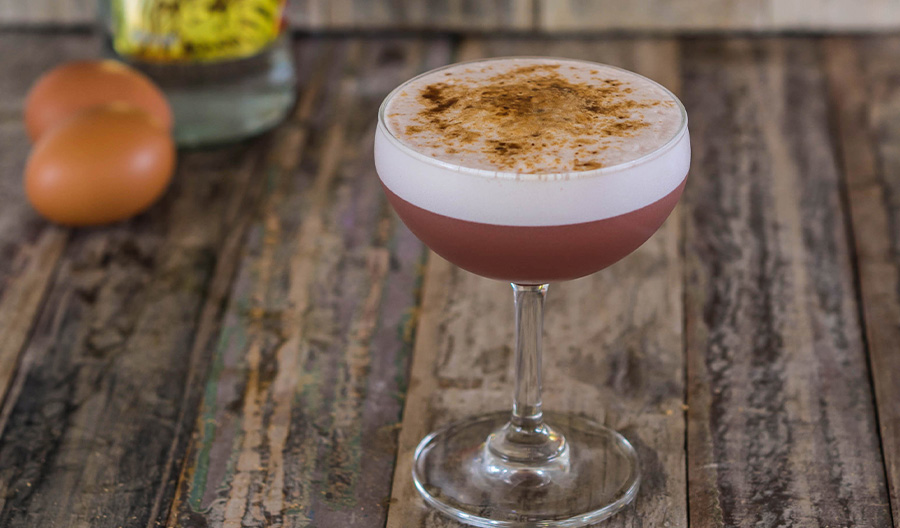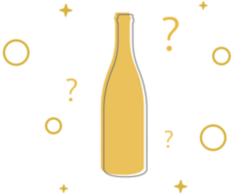Eggs have been used in cocktails since the very genesis of mixed drinks. From the early 1800s onward, whole eggs and egg yolks have been used to create rich, decadent serves such as the well-known seasonal Eggnog and the Tom & Jerry, as well as in flip-style cocktails. But it wasn't until post-Prohibition that imbibers really experienced the proliferation of egg-white-laced sours and fizzes—a trend that cemented itself into cocktail culture for good.
In food, eggs have long been used as binding agents to hold together otherwise-sloppy casseroles, emulsify sauces such as hollandaise and mayonnaise, and leaven foods such as soufflés and meringues. When using egg whites in cocktails, the application is most similar to the latter example. When making a French meringue (i.e., an unheated meringue), air is beaten into a mixture of egg whites, sugar, a stabilizing acid (typically cream of tartar or lemon juice), and vanilla extract to create a fluffy, voluminous foam which is used to top pies and other desserts. When air is incorporated into the protein molecules in egg whites, the proteins unwind and stretch to form an elastic web that encases the air bubbles, giving a meringue its characteristic wispy structure.
When making a cocktail with an egg white, a similar chemistry is at play to create the signature silky texture lent by the air-whipped (read: shaken) egg whites. Egg whites add a foam texture, mouthfeel and volume to a cocktail. They soften the edge of sour drinks and make them feel lighter, and they also make drinks look great.
For drink enthusiasts who are skeptical about egg whites in cocktails, note that citrus—a common ingredient that accompanies egg whites in cocktails—acts as a way to stabilize the mixture, with the alcohol content also playing a role, too. Research has shown that the chance of contracting salmonella from egg whites is approximately 1 in 30,000. Also, alcohol plays an important role in cutting those chances even lower. Sour cocktails with egg whites are some of the best sellers around, and luckily, it's very uncommon to hear of people getting ill.
If you’re using pasteurized eggs, which includes nearly all eggs sold in stores in the U.S., then there is little to worry about as far as food safety is concerned. Some alternative options are possible, too, like aquafaba (chickpea brine) or powdered egg whites. But most bartenders stick to the standard egg white for consistency and optimal volume.
More important, though, is how and when to mix them with egg whites to ensure that you’re using them safely and in the right drink formats.

When to Use Egg Whites in Cocktails
As is the case with any ingredient, certain drink applications are better than others, and this is especially true with egg whites. It is a best practice to only using egg whites in cocktails that use citrus. We’d even go further to say that this is the golden rule of using egg whites. While some other acid sources (such as acid solutions, vinegars, verjus, or wines) could perhaps replace citrus to stabilize the drink and add some freshness, citrus juice tends to pair best with egg whites and also cuts through the viscosity that egg whites bring to cocktails.
Many mixologists only tends to use egg whites in sour cocktails (which is to say, a cocktail primarily composed of a spirit, citrus juice, and a sweetener). Egg whites work best to remove a bit of the sharp edge from the citrus sour component. Without an acidic juice component, mixing with egg whites is a recipe for disaster; so keep that key point in mind.
In addition, it’s important to use fresh egg whites. Egg whites must be shaken and fresh as possible to work their best. Using fresh eggs can also help avoid the eggy smell that can occur when the drink sits around for a few minutes. Using a few drops of bitters, expressing a citrus zest, or grating nutmeg can help mitigate that unwanted aroma.
This rule regarding when to use egg whites is fairly simple, but the technical aspect of mixing with them is where the details really matter.
Nailing the Technique
If you’ve ever heard a bartender talk about “dry shaking” and “wet shaking,” then you’re familiar with the technical terms needed to mix with egg whites. Shaking with ice allows you to chill and dilute your cocktail, but 'dry shaking,' (which is to say, shaking without ice) allows you to maximize the effect of emulsification by unravelling the proteins so they can trap the maximum amount of air in your drink.
When building a cocktail with egg white, assuming you’re using two-piece mixing tins rather than a cobbler shaker, add the egg whites to one tin while building the rest of the cocktail in the small tin. The reason for this is that if you happen to get any of the shell in the tin, you can easily remove it without contaminating the entire cocktail. Once you’ve properly built the cocktail, you’ll want to seal your tins and give a dry shake without ice. Take care when dry shaking. The cocktail shaker might try to push itself apart, because warm drinks don’t seal the shaker tightly like cold ones do. This is partly because without the ice, there’s no drop in pressure within the tins to create a vacuum.
Instead of using dry shaking and wet shaking, some bars employ a blender to mix egg-white cocktails. Tey using a blender to mix sours, using only one ice cube. The single ice cube contains the exact amount of dilution needed in the drink, and it’s enough to properly chill the cocktail as well. The blender adds the right amount of volume and air and wastes less ice, energy, and valuable time. After blending fine-strain the cocktail to trap any ice shards or larger bits. This results in a silkier texture. Other helpful tools, if a blender isn't handy, are a single-serve blender like NutriBullet or a small handheld milk frother. These tools will always give you a consistent dry shake.
Any of the techniques above will work, regardless of whether you’re making an Amaretto Sour, a Clover Club, or a Pink Lady. The crucial matter is figuring out what works best for you by practicing. And, don’t worry, if you spill an egg white cocktail while dry shaking, we’ve all been there. The resulting frothy, silky cocktail is always worth any mess.

